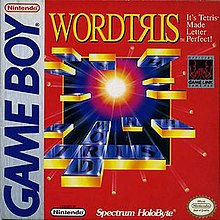Wordtris
Wordtris is a Tetris offshoot designed by Sergei Utkin, Vyacheslav Tsoy and Armen Sarkissian and published by Spectrum Holobyte in 1991 for the IBM PC platform. The game was released for the Game Boy (ported by Realtime Associates) and Super NES in 1992.
| Wordtris | |
|---|---|
 Cover art of Wordtris | |
| Developer(s) | Realtime Associates |
| Publisher(s) | Spectrum HoloByte |
| Designer(s) | Sergei Utkin Vyacheslav Tsoy Armen Sarkissian |
| Composer(s) | Ed Bogas (PC, Game Boy, Mac) Paul Mogg (SNES) |
| Platform(s) | MS-DOS, Game Boy, Macintosh, Super NES |
| Release | 1991 |
| Genre(s) | Puzzle |
| Mode(s) | Single-player, Multiplayer |
The object of the game is to build words of three letters or more using the tiles that fall from the top of the playing area. Words can be constructed horizontally or vertically, and multiple words can overlap each other. If the player manages to construct the magic word at the top of the screen, the well will be cleared of all tiles and the player will receive a large bonus.
Occasionally, a free tile (denoted by a "?") will drop. Its letter can be selected by the player (either by typing it in the PC version, or scrolling through letters with a button on the console versions). If the player does not choose a letter, the block will become a random letter when it stops. Eraser blocks will fall and remove whatever letter that they land on (in the SNES version, the eraser is replaced with bombs and vials of acid).
In the Super NES version, players advance from levels "A" to "J."[1] There is no level after "J."
The background pictures (except the title screen) were taken from an earlier Tetris game by Spectrum Holobyte known as Super Tetris. The in-game music is composed by Paul Mogg who did the PC version of Super Tetris with Ed Bogas.
Soundtrack
The PC, Game Boy, and Macintosh versions of Wordtris feature original music by Ed Bogas, while the SNES version features music by Paul Mogg. Paul also worked on the computer versions but only worked on sound effects design. While the Game Boy and SNES versions contain looping music, the other ports do not. Ed composed the soundtrack for Wordtris using his own music software Super Studio Session for the Macintosh, in which his MIDI files were converted to the game in MIDI format. For the SNES version, Paul composed his music using Studio Vision Pro, also for the Macintosh. David Warhol provided sound engines and musical arrangements for both the Game Boy and SNES versions.
Reception
Computer Gaming World stated that "Wordtris, like its predecessors, is as infuriating as it is incredibly addictive ... Tetris is a classic game. Wordtris does it one better".[2] The SNES version of the game was scored a 65% by N-Force Magazine.[1]
References
- Rice, Chris ed. "Wordtris." SNES N-Force Magazine. Issue 07. Pg.69-70. December 1994.
- Lasky, Michael S. (December 1991). "In a Word, "Yes!"". Computer Gaming World. p. 102. Retrieved 18 November 2013.